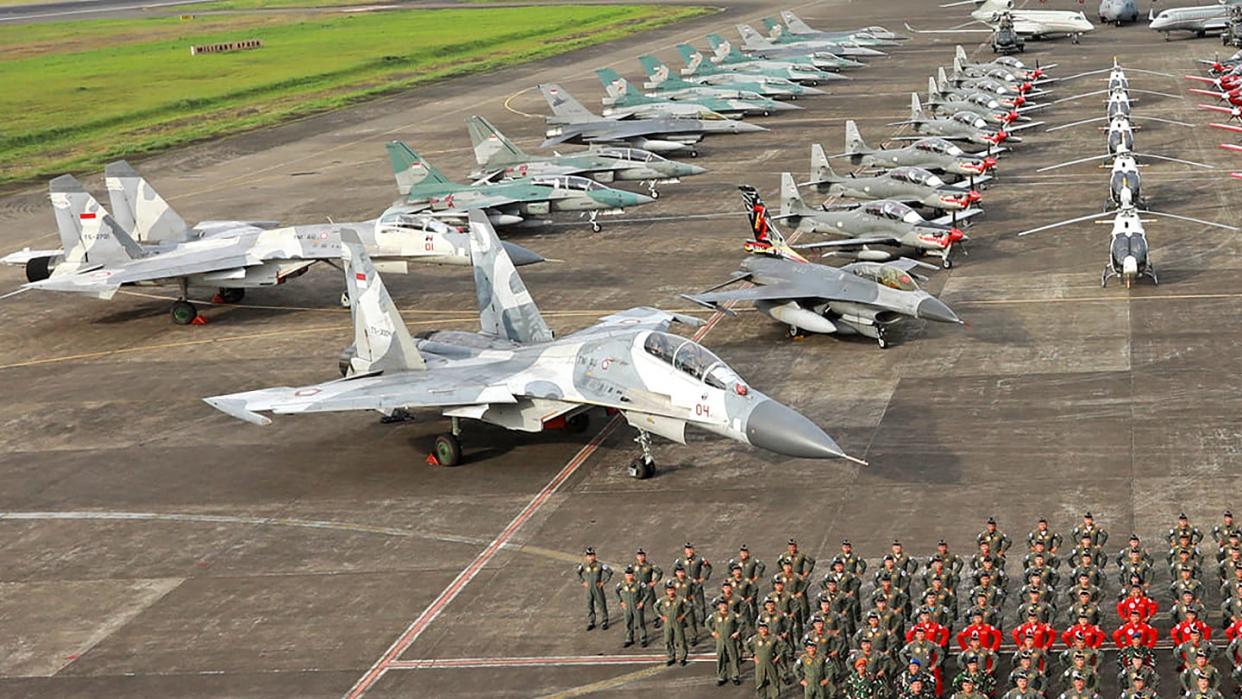This Shot Is A Reminder Of Just How Huge The Flanker Is

It’s often difficult to get a sense of the scale of aircraft when looking at pictures of them in flight. However, when aircraft are assembled together and photographed on the ground it’s possible to get a better sense of their differing sizes. Case in point: Look at the size of the Indonesian Air Force’s Russian-made Sukhoi Flanker fighter jets, seen toward the front of the gaggle of aircraft in the top shot above, compared to nearby F-16s, T-50 Golden Eagles, and other aircraft.
The photo in question was taken on April 9, following the Indonesian Air Force’s 77th-anniversary ceremony held at Halim Perdanakusuma Air Force Base, East Jakarta. As part of the anniversary celebrations — which were chaired by Admiral Yudo Margono, commander of the Indonesian National Armed Forces — members of the public saw various aerial and ground demonstrations by Indonesian Air Force personnel. You can watch footage from the celebration below.
In the photo, Indonesian Air Force Chief of Staff Marshal Fadjar Prasetyo and members of the Dynamic Show Team crew stand in front of an impressive lineup of aircraft. The four Flankers circled in red below are, from left to right, a Sukhoi Su-27SK (TS-2701), a Su-30MK2 (TS-3004), a Su-30MK (TS-3001), and another Su-30MK2 (TS-3005). For an understanding of their size in broad strokes, the Su-30MK2 is roughly 71 feet in length, has a wingspan of just over 48 feet, and measures just over 20 feet in height.
In addition to the Flankers, the impressive aircraft lineup includes two H225M multirole helicopters; two recently delivered Dassault Falcon 7X VIP transport jets; five Eurocopter EC120 Colibri training helicopters; five KAI T-50I Golden Eagle advanced jet trainers; seven KAI KT-1 Woong Bee basic training aircraft; nine EMB-314 Super Tucano light attack aircraft; one C-130 Hercules transport aircraft; and no fewer than 17 F-16s, including one near the front of the second row with a special anniversary tail paint scheme. F-16A/Bs, compared to the Su-30MK2 for example, have a length of just over 47 feet, a wingspan of around 31 feet, and measure just over 16 feet in height.
At 62 m² the Sukhoi Su-30’s wing area is twice that of an F-16. It also has an empty weight of 17,000 kg, the same as that of a Boeing B-17 Flying Fortress bomber of #WWII! It's ginormous...#avgeeks #aviation #aviationlover #aviationdaily #Indonesia pic.twitter.com/uT4JcsJ6Tp
— Air Power (@RealAirPower1) January 4, 2023
Of course, it should be noted that the arrangement of the aircraft in the line-up, with the Flankers closest to the front, exaggerates the size differences between the aircraft a bit.
The Indonesian Air Force’s fleet of Russian-made Flankers, as The War Zone indicated in 2022, includes five single-seat Su-27SKs and a pair of two-seat multirole-capable Su-30MKs, deliveries of which started in 2003. It also comprises nine of the more advanced two-seat Su-30MK2s, the first of which touched down in the country in 2008. Alongside its Flankers, the Indonesian Air Force’s primary fighter fleet also includes in the region of eight F-16A/B Block 15OCU fighters, delivered from 1989, and roughly 23 upgraded F-16C/Ds.
Indonesian Air Force Sukhoi Su-27SK Flanker at Halim Perdanakusuma International Airport, April 2016. PK-REN via Wikimedia Commons
Jakarta was linked with a $1.1-billion deal in July 2017 to procure 11 examples of the multirole, single-seat Sukhoi Su-35 Flanker. However, after attempts by the U.S. to pressure Indonesia into shelving the deal, any indication that the country might be purchasing such aircraft was squashed in late 2021. Indonesia ended up choosing France’s Dassault Rafale fighter jets in February 2022, purchasing 42 examples in a bid to overhaul its air force. According to the French newspaper La Tribune, an additional tranche of 18 Rafales, on top of the original 42 ordered in February 2022, was committed to by Indonesia in March 2023.
A prototype Sukhoi Su-35 performing at the MAKS 2009 airshow in Moscow. Oleg Belyakov via Wikimedia Commons
According to Admiral Margono, aircraft demonstrations and assemblies performed during the recent anniversary celebrations send an important message regarding the advancements made by the Indonesian Air Force since its foundation in 1946. Speaking to the Indonesian news agency Antara, Margono indicated, “TNI AU [the Indonesian Air Force] has grown to be a more modern military organization beloved by the people. [The event shows] TNI AU’s commitment to continue revving up its capability to face an increasingly complex threat spectrum.”
Located at the southern end of the South China Sea, Indonesia has invested heavily in its defense capabilities in recent years owing to threats posed by China in the broader Indo-Pacific region. Indeed, the country has had its share of maritime incidents with Chinese vessels over the past years and is currently working to establish a code of conduct (COC) with China for the South China Sea, an area that has seen deployments of Indonesian Air Force jets in the past.
That said, the recent image not only highlights the Indonesian Air Force’s varied capabilities but just how different the sizes of its aircraft are too.
The War Zone Staff Writer Thomas Newdick contributed to this article.
Our thanks to Roni Sontani (@Roni_Sont) for highlighting the image on Twitter.
Contact the author: oliver@thewarzone.com

